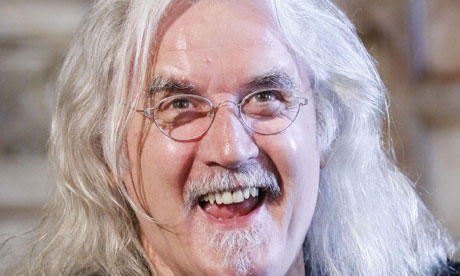
More evidence has emerged suggesting that The Hobbit, Peter Jackson's forthcoming two-part prequel to his own Lord of the Rings trilogy, might just be a very different beast to its predecessors. With the news that Billy Connolly is to take the role of dwarf king Dain Ironfoot in his adaptation of JRR Tolkien's debut Middle-earth-set novel, Jackson appears to be taking stunt casting on the project to a level of which even Quentin Tarantino might be proud.
One of the factors which gave the Kiwi film-maker's earlier triptych its potent air of authenticity was the relative absence of familiar faces in key roles. The films were shot in New Zealand and lesser-known actors from the Antipodes such as then-relatively-obscure Karl Urban (Eomer), David Wenham (Faramir), Miranda Otto (Eowyn) and the irreplaceable John Noble (Denethor) took many of the supporting parts. It may have been a matter of convenience, but it lent the series a freshness and originality that might otherwise have been missing.
The Hobbit, by contrast, has already given us a lineup of dwarves and halflings that might have come straight from the little black book of a BBC TV casting director. Martin Freeman and Benedict Cumberbatch (Sherlock), Richard Armitage (Spooks, Robin Hood), Aidan Turner (Being Human), James Nesbitt (everything): Jackson could not have given us more familiar small screen faces had he decided to replace Cate Blanchett as Galadriel with the woman who played Ace in Doctor Who and parachuted in Keith Chegwin to portray Gandalf.
I must admit that the decision to cast Barry Humphries as The Goblin King struck me as genius when it was announced last year. But is it really so necessary for the Master of Lake-town to appear in the smug yet cuddly form of dear old Stephen Fry and wizard Radagast the Brown to arrive in the shape of ex-timelord Sylvester McCoy? I suspect these appearances will make it rather harder for us Brits to lose oneself in the story, a bit like if Luke Skywalker had been played by a young Phillip Schofield in the first Star Wars movie, with Roland Rat as Yoda in The Empire Strikes Back.
Connolly's appointment, in particular, seems likely to add an air of pantomime to the proceedings. While the Scots comic is a fine actor, his appearance as dwarf king Dain Ironfoot can be little more than a cameo at the end of part two of The Hobbit: There and Back Again. In Tolkien's fable-like novel, Dain turns up at the Battle of Five Armies to give his cousin Thorin a hand in his battle to defend newly liberated Erebor from invading forces of goblins, elves, men and wargs. The decision to cast a famous face in the role smacks of the kind of thinking that led the makers of Robin Hood: Prince of Thieves to send in Sean Connery at the end of that rather glib Hollywood feature. Dain won't have much screen time, yet needs to make an instant impact: casting an actor of Connolly's status and gravitas instantly does the trick, but it's a quick and easy fix to a problem that (for me) deserved a more honest solution.
I hope this post won't be misread as some kind of anti-Jackson polemic. I have high hopes for The Hobbit and plenty of trust in the director's ability to produce two excellent films. But the casting approach has clearly been very different this time around. To audiences in the US and elsewhere, it may matter little. But to those of us in the UK who'll be more familiar with the actors involved, these movies may just lose a little of the mystery that informed the earlier trilogy.

